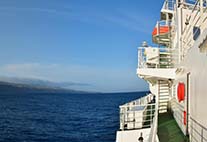On board the METEOR: Researchers explore submarine volcanoes in the Azores archipelago
15 January 2015, by Franziska Neigenfind

Photo: UHH/CEN/M. Schneider
An international team on board the research ship METEOR is currently taking measurements in the Azores archipelago. The researchers ...
An international team on board the research ship METEOR is currently taking measurements in the Azores archipelago. The researchers are working to identify the risks posed by submarine volcanoes and underwater mudslides in the Atlantic. Led by Prof. Christian Hübscher from Universität Hamburg’s Center for Earth System Research and Sustainability (CEN), the expedition’s participating institutions also include the Universities of Erlangen, Lisbon, Athens and Paris (South).
The expedition started on December 29 near São Miguel, the largest of the nine islands that make up the Azores. The initial findings from sediment samples gathered to the southeast of São Miguel indicate that the local submarine volcanoes are no longer active. “We didn’t detect any volcanic activity in the Princess Alice Bank, a seamount farther to the west, either,” adds Hübscher.
The geophysicist and his team are also seeking to determine whether collapsing shoreline cliffs on Pico Island could have set off tsunamis in the past. As Hübscher elaborates, “The risks involved when cliffs like these collapse don’t just depend on the volume of material that breaks off; how quickly it happens and the intervals between events are also key factors.” In order to estimate the risks posed by Pico’s cliffs, the researchers are investigating the remains of past landslides underwater with the help of a multibeam echosounder and a seismic reflection method that can produce images of cross-sectional areas of the seabed.
In the course of their work, the scientists also encountered an unusual structure: a round crater on the ocean floor with a hill-like formation in the middle. These rarely seen underwater structures are informally referred to as “fried eggs.” It was previously assumed that these craters were the scars left behind by 17-million-year-old meteorite impacts. “We now know that we can discount that hypothesis,” explains Hübscher. “Here on board we’re still discussing a number of alternative models, but we’re confident that we’ll soon unravel how these distinctive structures were formed.”
Here you can find the latest news from the research ship METEOR in the expedition reports (in German).
